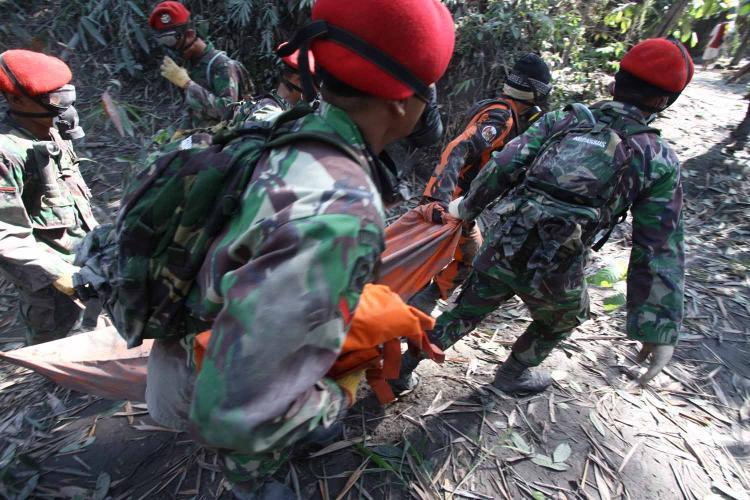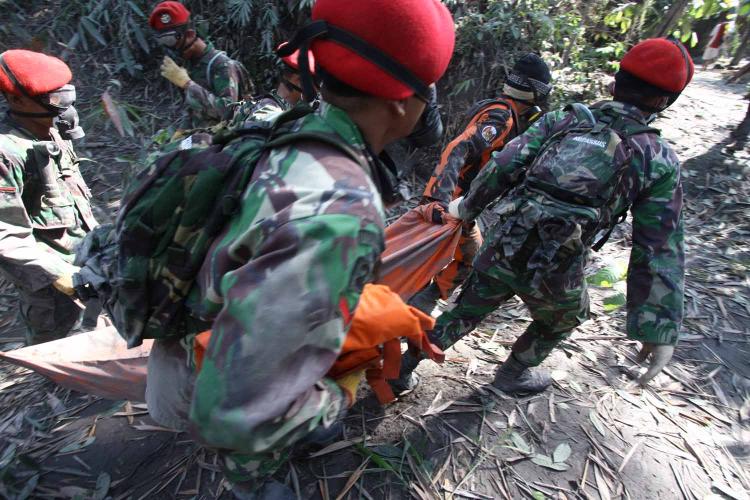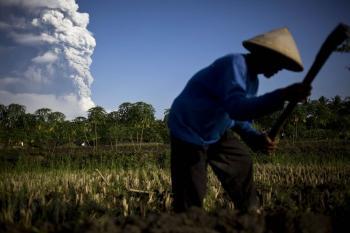YOGYAKARTA, Indonesia—With Mount Merapi quiet for the moment, search and rescue teams are taking advantage of the volcano’s silence to step-up recovery efforts.
On Friday morning, local time, nine more bodies were extracted from the ash and rock near Mount Merapi. Search and rescue teams, consisting of Indonesia military personnel, police, and volunteers, found the victims in the Cangkringan District of Yogyakarta Province. As of Friday evening, the death toll since Mount Merapi started erupting on Oct. 26 had reached 161 with more bodies being recovered throughout the day. The nine bodies were taken to Sardjito hospital in Yogyakarta.
While Indonesia’s most active volcano has been quiet for the past few days, the Indonesian government has not yet declared Mount Merapi safe.
The uncertainty of what Mount Merapi could do next, creates a new set of problems for government officials and volunteers. The tens of thousands of people who had to flee their homes and now live in refugee camps are anxious to return home. But there is concern that this could lead to chaos as survivors may plunder whatever property and animals survived fury of Merapi.
The other concern, of course, is that the volcano could erupt again. Major eruptions are usually accompanied by hot clouds with temperatures that can reach up to 1,470 degrees Fahrenheit (800 Celsius) and travel at speeds of up to 250 miles per hour (400 km/hr) over a 9 mile (15 km) range.
Locals are being allowed to return to their villages for limited times only because Mount Merapi is still active and producing small hot clouds.
Security has been greatly tightened within a 20 km (14 miles) radius of the peak. The identity of anyone crossing into the disaster-prone area is examined closely, including baggage, in an effort to help protect the property and personal safety of villagers returning home.
“In addition to local residents being barred from entering. If people are not from our village we do a thorough check, including luggage,” said one police officer.
“If you want, you can go back to the village just to take enough clothing, do not feed the animals. We do not allow residents who return to the village to give livestock feed,” the officer said.
On Friday morning, local time, nine more bodies were extracted from the ash and rock near Mount Merapi. Search and rescue teams, consisting of Indonesia military personnel, police, and volunteers, found the victims in the Cangkringan District of Yogyakarta Province. As of Friday evening, the death toll since Mount Merapi started erupting on Oct. 26 had reached 161 with more bodies being recovered throughout the day. The nine bodies were taken to Sardjito hospital in Yogyakarta.
While Indonesia’s most active volcano has been quiet for the past few days, the Indonesian government has not yet declared Mount Merapi safe.
The uncertainty of what Mount Merapi could do next, creates a new set of problems for government officials and volunteers. The tens of thousands of people who had to flee their homes and now live in refugee camps are anxious to return home. But there is concern that this could lead to chaos as survivors may plunder whatever property and animals survived fury of Merapi.
The other concern, of course, is that the volcano could erupt again. Major eruptions are usually accompanied by hot clouds with temperatures that can reach up to 1,470 degrees Fahrenheit (800 Celsius) and travel at speeds of up to 250 miles per hour (400 km/hr) over a 9 mile (15 km) range.
Locals are being allowed to return to their villages for limited times only because Mount Merapi is still active and producing small hot clouds.
Security has been greatly tightened within a 20 km (14 miles) radius of the peak. The identity of anyone crossing into the disaster-prone area is examined closely, including baggage, in an effort to help protect the property and personal safety of villagers returning home.
“In addition to local residents being barred from entering. If people are not from our village we do a thorough check, including luggage,” said one police officer.
“If you want, you can go back to the village just to take enough clothing, do not feed the animals. We do not allow residents who return to the village to give livestock feed,” the officer said.





